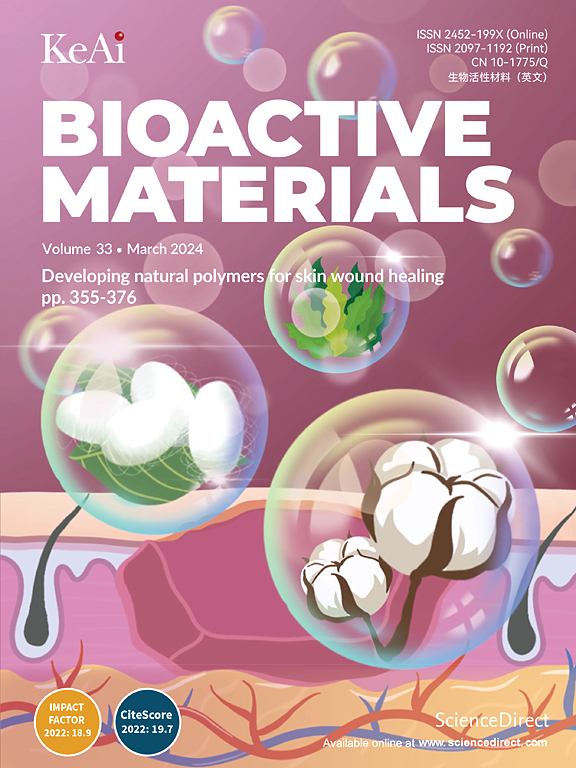Noninvasive method for achieving the regeneration of damaged nerves via ultrasonic nasal drops
IF 18
1区 医学
Q1 ENGINEERING, BIOMEDICAL
引用次数: 0
Abstract
Repair and regeneration of damaged neurons is a promising therapeutic strategy for central nervous system (CNS) diseases such as ischemic stroke (IS). However, achieving efficient neuronal repair and regeneration after CNS injury through noninvasive methods remains a significant challenge. Therefore, this study proposes, for the first time, an ultrasonic nasal drop formulation that induces efficient regeneration of damaged neurons through electropharmacological coupling in an noninvasive manner. Liposomes containing the natural anti-inflammatory drug Timosaponin B-II (TB) were coated onto barium titanate nanoparticles (BTO) to form LTO@TB. Using microfluidic technology and a Schiff base reaction, LTO@TB was encapsulated into aldehyde-based and methacrylate-modified microspheres (MS) to create the ultrasonic nasal drop MS@LTO@TB. The aldehyde groups of MS@LTO@TB spontaneously formed amide bonds with the numerous amino groups in the nasal mucosa, facilitating specific adhesion. Due to its enhanced bioadhesion and efficient transmembrane transport, LTO@TB was continuously and noninvasively delivered to the brain when administered nasally. Additionally, under ultrasonic stimulation, LTO@TB in the brain exerted an electropharmacological coupling effect, achieving noninvasive electrical stimulation of damaged neurons. MS@LTO@TB modulated microglial phenotypes, restored electrical signal conduction among damaged neurons, reshaped the inflammatory microenvironment, reduced neuronal apoptosis, activated the PI3K/AKT signaling pathway, and promoted axonal regeneration. MS@LTO@TB also showed the unique ability to alleviate inflammation and promote neuronal remodeling in a mouse model of middle cerebral artery occlusion/reperfusion (MCAO/R). This study presents a promising strategy involving the nasal administration of ultrasonic nasal drops as a noninvasive and efficient treatment for CNS injuries.

利用超声滴鼻液实现受损神经再生的无创方法
损伤神经元的修复和再生是治疗缺血性脑卒中等中枢神经系统疾病的一种很有前途的治疗策略。然而,通过无创方法实现中枢神经系统损伤后有效的神经元修复和再生仍然是一个重大挑战。因此,本研究首次提出了一种超声滴鼻制剂,该制剂通过电药理学偶联以无创方式诱导受损神经元的有效再生。将含有天然抗炎药铁皂苷B-II (TB)的脂质体包被在钛酸钡纳米颗粒(BTO)上形成LTO@TB。利用微流控技术和希夫碱反应,将LTO@TB包封在醛基和甲基丙烯酸酯修饰的微球(MS)中,制成超声波滴鼻剂MS@LTO@TB。MS@LTO@TB的醛基团自发地与鼻黏膜中的众多氨基形成酰胺键,促进特异性粘附。由于其增强的生物黏附性和有效的跨膜运输,LTO@TB在鼻腔给药时可以连续且无创地输送到大脑。此外,在超声刺激下,大脑中的LTO@TB发挥电药理学偶联作用,实现对受损神经元的无创电刺激。MS@LTO@TB可调节小胶质细胞表型,恢复受损神经元的电信号传导,重塑炎症微环境,减少神经元凋亡,激活PI3K/AKT信号通路,促进轴突再生。MS@LTO@TB在大脑中动脉闭塞/再灌注(MCAO/R)小鼠模型中也显示出独特的减轻炎症和促进神经元重塑的能力。本研究提出了一种有前途的策略,包括使用超声滴鼻液作为一种无创和有效的治疗中枢神经系统损伤的方法。
本文章由计算机程序翻译,如有差异,请以英文原文为准。
求助全文
约1分钟内获得全文
求助全文
来源期刊

Bioactive Materials
Biochemistry, Genetics and Molecular Biology-Biotechnology
CiteScore
28.00
自引率
6.30%
发文量
436
审稿时长
20 days
期刊介绍:
Bioactive Materials is a peer-reviewed research publication that focuses on advancements in bioactive materials. The journal accepts research papers, reviews, and rapid communications in the field of next-generation biomaterials that interact with cells, tissues, and organs in various living organisms.
The primary goal of Bioactive Materials is to promote the science and engineering of biomaterials that exhibit adaptiveness to the biological environment. These materials are specifically designed to stimulate or direct appropriate cell and tissue responses or regulate interactions with microorganisms.
The journal covers a wide range of bioactive materials, including those that are engineered or designed in terms of their physical form (e.g. particulate, fiber), topology (e.g. porosity, surface roughness), or dimensions (ranging from macro to nano-scales). Contributions are sought from the following categories of bioactive materials:
Bioactive metals and alloys
Bioactive inorganics: ceramics, glasses, and carbon-based materials
Bioactive polymers and gels
Bioactive materials derived from natural sources
Bioactive composites
These materials find applications in human and veterinary medicine, such as implants, tissue engineering scaffolds, cell/drug/gene carriers, as well as imaging and sensing devices.
 求助内容:
求助内容: 应助结果提醒方式:
应助结果提醒方式:


